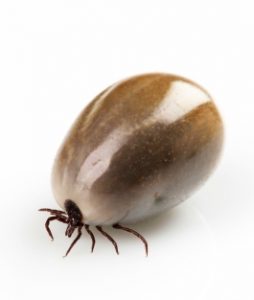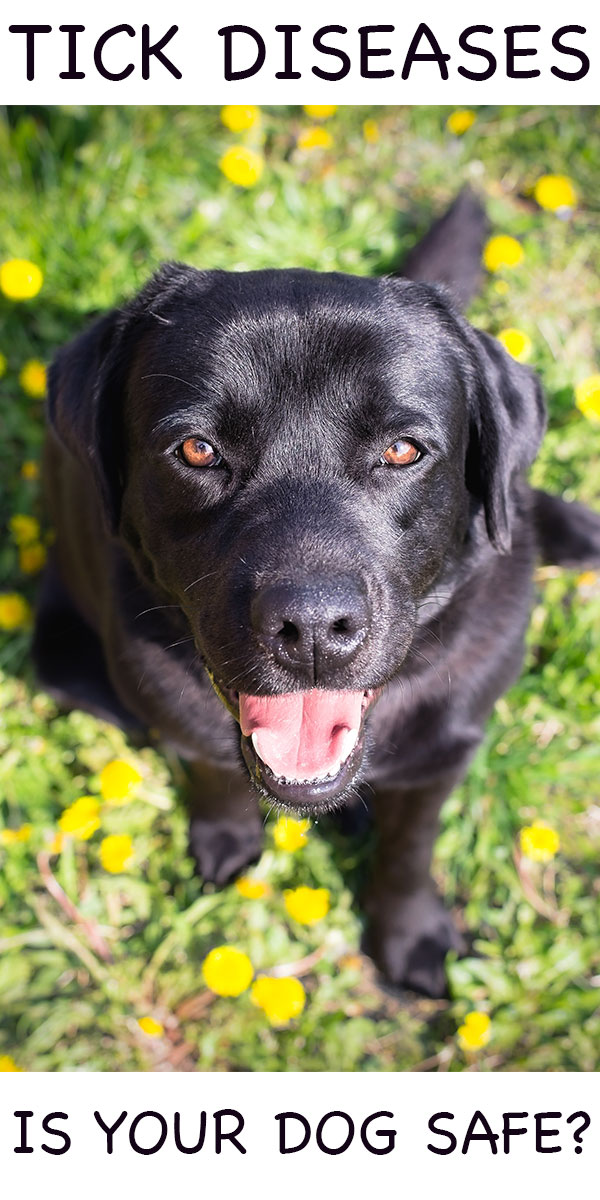Ticks On Dogs: Tick Bites, Tick Removal & Tick Diseases
Ticks on dogs are no joke. In this article we are going to look at what to do if your Labrador has a tick, how to safely remove it and what tick diseases and symptoms you need to look out for.
Products included in this article were carefully and independently selected by the Labrador Site team. If you decide to make a purchase from one of the links marked by an asterisk, we may earn a small commission on that sale. This is at no extra cost to you.
Ticks on Dogs
Not only do ticks look disgusting, they have the potential to make your dog very unwell.

It is important to remove ticks from your dog (and from yourself!) promptly, to reduce health risks from the diseases that they carry.
Tick Removal
When you find a tick on your Lab, the first thing you should do is to carefully remove it. The longer a tick is attached, the greater the risk of infection is. If you find a tick on your dog, never squeeze it or put any chemicals onto it in an attempt to remove it. Doing so will increase the risk of infectious material being pushed into the bloodstream.
Removing Ticks From Your Dog
The best way to remove dog ticks is with a specialised tick remover. We use this tick remover*(paid link) for our Labradors, and find it very effective.

Simply put the tick remover underneath the tick, where it is joined to your Lab’s skin, and twist it around until the tick is released. It won’t leave the mouth parts behind, or squeeze any potentially dangerous material into your dog in the process.
This particular pack comes with two different sized hooks, so you can correctly fit it to the size of the tick on your dog. When you have removed the tick, put it straight into an outdoor garbage can, sealed away from your family and pets.
Tick Diseases
Tick diseases can affect any dog that is bitten by a tick. Although the area you live in will impact his chances of getting each disease.
Although Lyme Disease is the most well known tick disease, there are a variety of others which could impact your dog’s health after he is bitten. These diseases share many symptoms, and if your dog has been bitten and seems to displaying any of them your first port of call should be your local veterinarian. Let’s have a look at the diseases in turn, so that you can understand what they do and the symptoms you need to be looking out for.
Lyme Disease
Lyme Disease is the main concern to dog owners when it comes to tick diseases. Especially for those who live in affected areas. Certain locations around the United States and United Kingdom contain reported cases of Lyme Disease being carried by ticks. If you are uncertain whether you live in a Lyme Disease risk area, give your local veterinarian a call to check. If your area has not had reported cases of Lyme Disease then you are far less likely to have your dog affected after being bitten by a tick.
Also known as Borreliosis, Lyme Disease is transmitted when a tick bites into the skin and holds on for more than 48 hours. If you remove the tick shortly after your dog is bitten, then the chances of him contracting Lyme Disease are slim.
The symptoms of Lyme Disease can be very hard to spot in dogs, but may include one or several of the following:
- Lameness from swollen joints
- Reluctance to move around or get up
- Tiredness
- Fever
- Swollen lymph nodes
Dogs in the later stages of Lyme Disease can also suffer from kidney disease, heart conditions and nervous system disorders. If your veterinarian suspects that your dog has Lyme Disease they will carry out a blood test to diagnose them. Lyme Disease can be effectively treated using antibiotics, provided it has not caused long term to any organs.
Babesiosis
Babesiosis is a tick disease which affects the red blood cells. Single celled organisms called Protozoa infect the red blood cells, causing the dog to become anaemic. When your dog’s immune system attacks these infected cells, he will start to display symptoms including:
- Tiredness
- Limpness or weakness in the limbs
- Pale gums
- Vomiting
- Dark urine
- Lack of appetite
- Collapse
This disease moves in progressive phases, which can be exacerbated by other factors such as stress and immunodeficiency. Sadly, if your dog has been infected there is a chance of later relapse, so you will need to remain vigilant and look out for these symptoms.
Babesiosis is primarily contracted through tick bites, but can also be passed along by an infected dog biting your dog. So watch out for symptoms of this following a bite from an unknown dog as well as after a tick bite.
Erhlichiosis
Ehrlichiosis is a white blood cell infection that can lead to problems with your dog’s bone marrow and the production of red blood cells. It is one of the most dangerous tick diseases that your dog could contract. The symptoms vary and can be hard to place, but if your dog has been bitten by a tick watch out for the following:
- Tiredness
- Low appetite
- Nasal discharge or bleeding
- Bruising, most noticeable in the gums and stomach
- Runny eyes
- Lameness
- Fever
- Incoordination
- Increased thirst
Ehrlichiosis has been confirmed throughout the United States, with the most prevalence perhaps in the Southwestern and Gulf Coast areas. If you are concerned your Labrador is displaying Ehrlichioisis symptoms and has recently had a tick bite less than a month ago, then contact your veterinarian regardless of your location for their advice. This condition will be diagnosed by a blood test, and can require up to a month of antibiotic treatment.
Anaplasmosis
Anaplasmosis is an infection of the white blood cells or platelets. Anaplasmosis has very similar symptoms to Ehrlichosis, although these can differ depending upon whether it has affected the white blood cells or platelets. Symptoms can include any of the following:
- Lack of appetite
- Tiredness
- Lameness
- Bruising
- Fever
- Nosebleeds
Blood tests or urine analysis will be used to confirm Anaplasmosis. Antibiotics are usually successful in curing the condition.
Rocky Mountain Spotted Fever
Although Rocky Mountain Spotted Fever (RMSF) would appear to be named for it’s region, it can actually be found throughout the USA and Canada. It is a very dangerous disease, and acts quite differently to those we’ve looked at above in terms of the period of illness.
Initially, the tick only needs to be attached to the dog for a few hours for them to contract the disease. Whereas symptoms of Lyme, Erlchiosis and Anaplasmosis come and go, Rocky Moutain Spotted Fever comes on quickly and lasts for two weeks. The severe symptoms can include
- Lameness
- Fever
- Lack of appetite
- Joint pain
- Vomiting
- Diarrhoea
It can also result in heart conditions, pneumonia, kidney failure, liver damage and seizures. This disease can be fatal, so if you suspect your dog may have picked it up from a tick bite contact your veterinarian without delay. They will diagnose the disease with a blood test, and put your dog on a course of antibiotics if he is infected.
Long term treatment or inpatient veterinary care might be required if the heart, kidneys or liver have been harmed.
Tick Bites
There is no way of telling whether a tick bite will infect your dog or not. You cannot see from visual examination of the tick whether they are carrying a disease. What you can do is look at the area you live in. If you live in a low risk area, then prompt removal and a quick clean of the area will mean your dog will probably be fine. But if you are at all concerned, give your vet a ring once it has been removed.
In people, an infected bite can sometimes trigger a rash in the tick bite area. If you have been bitten yourself, then consult your doctor. Also remember that juvenile ticks can be tiny, so it is possible you or your dog can be bitten without every being aware.
Tick Treatment For Dogs
You can reduce the chances of your dog being bitten by ticks, by using a spot on chemical tick treatment for dogs. These will often also provide flea treatment in the same drop. However, have a chat to your vet before you buy one as they will know which is the most appropriate.
It is possible to vaccinate your dog against some of the above listed tick born diseases. The availability and relevance of these vaccinations will depend upon your location, so give your veterinarian a call and ask them what they offer in your local area.
Tick Prevention
If possible, avoid walking your dog in areas with known tick infestations, or that have been flagged up as having a high risk of a tick born disease. If you want to reduce your own risk of picking up ticks from infested areas, then wearing long sleeves and tucking your trousers into your socks will help.
Tick prevalence is growing in the United States and the United Kingdom, but you don’t need to panic. Just make sure that you are tick aware, take all the preventative steps you can and remember to remove any ticks you find promptly. If you have any concerns that your dog is showing symptoms of a tick disease, please contact your veterinarian as soon as possible.
Affiliate link disclosure: Links in this article marked with an * are affiliate links, and we may receive a small commission if you purchase these products. However, we selected them for inclusion independently, and all of the views expressed in this article are our own.

Free Labrador Updates!
Get my training tips, news, reviews, and the latest from The Labrador Site delivered to your inbox




My female Labrador is suffering from huge tick issue pleae helm me see is our heart beat and we don’t want her to be alone and fighting with ticks on daily basis and also it has huge hair loss issue almost thousands of her hairs removing on daily basis
I’m always amazed at the timeliness of this newsletter! Just yesterday I removed a tick from my dog, that my wife had found a day or two earlier. Now thanks to this newsletter, I know that the ticks need to be removed immediately. She was afraid to remove it because she knew it could be made worse by leaving the head in. The tool mentioned looks much simpler to use than tweezers. I know my wife would be much more comfortable using that and will not waste time in the future.
Glad you found it helpful Robert 🙂